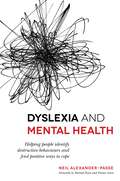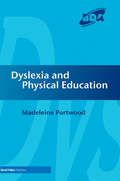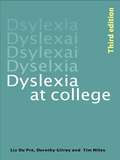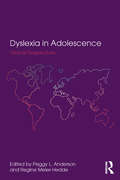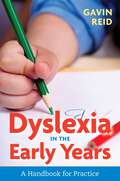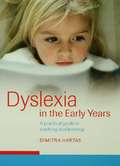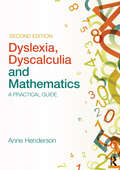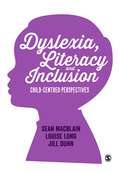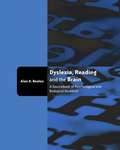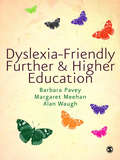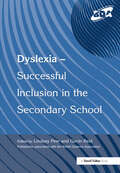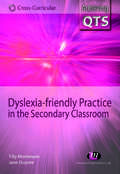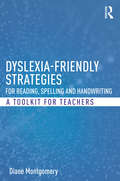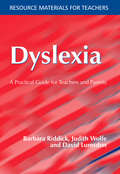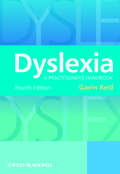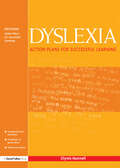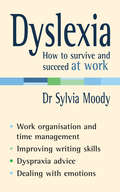- Table View
- List View
Dyslexia and Mental Health: Helping people identify destructive behaviours and find positive ways to cope
by Michael Ryan Neil Alexander-Passe Pennie AstonDyslexia is a complex condition that affects not only learning but every part of life. Experience or fear of social stigma can lead people with dyslexia to camouflage the difficulties they face, to withdraw and to adopt negative coping strategies, particularly if they lack adequate support, identification and intervention. This can have lasting impact on their emotional health. Neil Alexander-Passe is an experienced researcher and a special needs teacher in secondary mainstream education. He also has dyslexia. Neil uses his personal and professional experience to shed light on the complexities surrounding dyslexia and examines psychological theories such as ego-defence mechanisms and learned helplessness that reveal how people deal with its emotional impact. He offers guidelines and advice, illustrated with real life examples, about how to help people with dyslexia avoid harmful coping strategies and learn to deal with stress, anxiety and low self-esteem in more effective and psychologically positive ways. This book will help educational and clinical psychologists, teachers, mental health specialists, counsellors and therapists understand the emotional complexities of dyslexia.
Dyslexia and Physical Education
by Madeleine PortwoodMuch research has focused on dyslexia and co-ordination. This book examines the literature and provides a framework to support pupils with dyslexia, not only during PE lessons but in less structured environments, for example during break time when pupils are likely to be involved in physical activities.
Dyslexia and Spelling: Making Sense of It All
by Kelli Sandman-HurleyWritten by an authority in the dyslexia field, this is the first accessible guide to the close interplay of spelling and dyslexia. Kelli Sandman-Hurley talks the teacher or parent through why kids with dyslexia find spelling so hard, and what we can learn from the spelling mistakes in their writing samples. Introducing key terminology around morphemes (smallest unit of meaning in words) and phonemes (smallest contrastive units in language) in an accessible and clear way, Sandman-Hurley goes on to explain how we can identify, and learn from, kids' spelling miscues, and use them to further inform our teaching and instruction. Shedding much-needed light on an under-explored tool for classroom or home learning, Dyslexia and Spelling is essential reading for teachers and parents alike.
Dyslexia and Your Newly Diagnosed Child: Parenting Essentials, Tips, and Strategies to Help Your Child
by Rebecca Bush CALT, LDTDyslexia and Your Newly Diagnosed Child gives caregivers the practical guidance, tools, and knowledge they need to support the newly diagnosed 6- to 9-year-old in their lives.While caregivers may feel a sense of relief when their child receives a dyslexia diagnosis, now knowing why reading was such a struggle, they also face a lot of uncertainties about the future. This book offers insights, strategies, and tips for caregivers to support their child&’s learning and immediately address reading and writing challenges, while also nurturing areas like working memory, listening skills, and friendships, all of which can be indirectly impacted by dyslexia.This guide delivers:AN ESSENTIAL PRIMER: Understand dyslexia with a clear and simple introduction—perfect for caregivers who are just beginning their journey and learning about dyslexia.POWERFUL KNOWLEDGE: Receive expert insights designed for caregivers new to dyslexia. Develop a deeper understanding of your child&’s needs and confidently interact with educators, therapists, administrators, and doctors.EVERYDAY GUIDANCE: Use practical strategies to foster your child&’s learning and strengths. Implement visual cues to help with sound blending, brainstorm and use secret hand signals when listening comprehension is overwhelming, turn daily tasks into games, encourage your child to take ownership and establish reading routines at home, and help them describe their dyslexia to self-advocate and seek assistance. Prepare them to learn and overcome challenges effectively.EASY-TO-NAVIGATE PAGES: Soak up information right away with spacious layouts, bulleted lists, and helpful labels for busy parents.SUPPORT TO GROW AND LEARN TOGETHER: Observe and track your child&’s progress with reflection questions—identify what works, what needs improvement, and where you might need additional support.With this book as a road map, caregivers can take the driver&’s seat and guide their child toward independence and confidence until they&’re ready to take over.
Dyslexia at College
by T. R. Miles Dorothy Gilroy Elizabeth Ann Du PreThis fully updated third edition contains practical and useful advice that will be invaluable for students with dyslexia, their parents and all of those involved in teaching and supporting them in their studies. Including the latest research into dyslexia, changes in legislation and information technology and the real-life experiences of six former Bangor students this book will: • guide students through the process of applying for university, suggesting strategies for general organisation and for particular aspects of study • outline how to get the best personally and academically from higher education • give practical advice on setting up and using support facilities (both human and technological) • be an accessible text for mainstream lecturers and tutors who need to be aware of the implications of the Disability Discrimination Act. New chapters include 'Dyslexia plus', giving information on dyspraxia, attention disorders, Asperger's syndrome, and the more controversial 'dyscalculia'. ‘Out of College and into Work’ gives advice for students on the challenges they face after graduation.
Dyslexia in Adolescence: Global Perspectives
by Peggy L. Anderson Regine Meier-HeddeDyslexia in Adolescence: Global Perspectives presents international case studies on the psychosocial development and academic progress of adolescents with dyslexia to enhance understanding of adjustment factors, outcomes and support. The continuation of a qualitative longitudinal research project that focused on children between ten and twelve years of age, this volume revisits them between ages fourteen and sixteen. Through semi-structured interviews, personal narratives, and other assessments, these case studies relate the trials and tribulations associated with the development of adolescents with dyslexia from around the world and the challenges that parents face in supporting their children.
Dyslexia in Many Languages: Insights, Interactions and Interventions
by Gavin Reid Gad Elbeheri Angela FawcettDyslexia in Many Languages thoroughly investigates the fascinating relationship between dyslexia and language systems by highlighting research and practice initiatives around the world.Focusing on how dyslexia manifests itself in non-English languages, readers of this text will enhance their understanding and appreciation for the role of language systems and the interplay they have with dyslexia, assessment and intervention. Experienced and expert contributors around the world consider how dyslexia is defined, assessed, and supported in their native country, drawing on the linguistic features of that language and how this affects monolingual, bilingual and multilingual speakers. This book also compares dyslexia in different languages and questions what are the universal lessons that we can learn from comparing dyslexia in different languages and do different languages affect its prevalence and incidence? The editors consider the implications for classroom practice, such as learning and teaching challenges, the social emotional and educational impact on the child as a learner and considers the various sides of the educational process of students with dyslexia in different languages.This volume is essential reading for teachers and psychologists who deal with a large number of students and patients coming from different language backgrounds. Researchers and educators interested in dyslexia in different languages will also find its contents useful and relevant in their learning and work contexts.
Dyslexia in the Early Years: A Handbook for Practice
by Gavin ReidResearch has shown that early identification and intervention is crucial and can in fact minimise, and may even prevent, the challenges of dyslexia from becoming too detrimental at later stages of education. This book offers both research insights and practical guidance for teachers working in Early Years settings on how to create resource materials that would be suitable for the development of children with dyslexia. Beginning with a contextual note on the key difficulties faced by children at risk of dyslexia, the book takes the reader through the processes of identification and diagnosis, before offering ideas on how to tailor classroom materials for these students. The book's resource materials are designed to target areas such as reading, spelling, numeracy, language skills, social and emotional development, and problem solving skills.
Dyslexia in the Early Years: A Practical Guide to Teaching and Learning
by Dimitra HartasPacked full of activities, real-life case studies, tasks and suggestions, this informative book will equip teachers with the kind of practical knowledge needed to teach young children with dyslexia effectively. Tackling the subject in a clear and realistic way, the author encourages teachers to think critically in terms of the changing nature of special educational needs, and teaching and learning in early years. She addresses a variety of classroom issues, such as: assessment and identification of dyslexia summarising and commenting on current debates exploring the links between dyslexia, language, and social and emotional development the most effective instructional methods and teaching styles conducive to supporting pupils with dyslexia in early years settings. In addition the book considers the implications of current research for everyday classroom practice, makes recommendations for employing technologies and for accessing web-based information and resources.
Dyslexia in the Primary Classroom (Achieving QTS Cross-Curricular Strand Series)
by Wendy HallThis book is an important resource for all primary trainees. It provides an explanation of what dyslexia is and how it affects a child′s learning, suggests simple activities which can be used to screen children ready for referral and outlines some easy-to-follow activities addressing different learning styles. It is full of practical suggestions on how to teach reading, spelling and mathematics, develop writing and help with classroom organisation for children displaying difficulties in these areas. The Primary National Strategy is considered throughout and clear links are made to the Professional Standards for the Award of QTS.
Dyslexia, Dyscalculia and Mathematics: A practical guide
by Anne HendersonDyslexia, Dyscalculia and Mathematics will be an essential resource for teachers, classroom assistants, and SENCOs who help dyslexic and dyscalculic children with their understanding of mathematics. Written in an accessible style with helpful illustrations, this practical book reveals helpful ways in which to tackle both simple and complex concepts with students of all ages. This second edition has been updated to include references to using technology that will help children with dyslexia and dyscalculia reinforce their mathematical skills and also contains a number of photocopiable resources that can be used in the classroom. Written by Anne Henderson, who is experienced in teaching language and mathematics to pupils with dyslexia and dyscalculia, this book outlines current thinking in the field and shows how the research methods that have been proven as successful can be used with whole classes of children. This book encourages flexible methods and gives teachers the confidence to discuss alternative solutions with their pupils and help them achieve success. It is an ideal handbook for parent-teacher programmes and is also suitable for in-service training.
Dyslexia, Literacy and Inclusion: Child-centred perspectives
by Sean Macblain Dr Jill Dunn Louise LongThis book is about raising standards in literacy for children with dyslexia by putting the child at the centre of everything you do, focusing on wellbeing, and recognising the role that adults have to play in ensuring all children reach their potential. Concentrating on children in primary schools and early years settings the book looks at: Early intervention Pupil voice Working as a team New literacies Child-centred identification, assessment and provision Challenges for the inclusive school. Suitable for all those working with children with dyslexia this book contains strategies that can be easily adopted to academically and emotionally benefit the children you are working with.
Dyslexia, Literacy and Inclusion: Child-centred perspectives
by Dr Jill Dunn Louise Long Sean MacBlainThis book is about raising standards in literacy for children with dyslexia by putting the child at the centre of everything you do, focusing on wellbeing, and recognising the role that adults have to play in ensuring all children reach their potential. Concentrating on children in primary schools and early years settings the book looks at: Early intervention Pupil voice Working as a team New literacies Child-centred identification, assessment and provision Challenges for the inclusive school. Suitable for all those working with children with dyslexia this book contains strategies that can be easily adopted to academically and emotionally benefit the children you are working with.
Dyslexia, Reading and the Brain: A Sourcebook of Psychological and Biological Research
by Alan BeatonDespite the wealth of literature available on the subject of dyslexia, there is little that explores the subject beyond a single theoretical framework. The need for a comprehensive review of the literature by both researchers and practitioners from different fields and theoretical backgrounds is the central motivation behind Dyslexia, Reading and the Brain. By combining the existing fragmented and one-sided accounts, Alan Beaton has created a sourcebook that provides the much-needed basis for a more integrated and holistic approach to dyslexia.The book is divided into two sections: the first, The Cognitive Context, outlines the theoretical context of normal reading development and introduces the role of phonological awareness and the relation between dyslexia and IQ. Section two, The Biological Context, provides an explanation of the genetic background as well as exploring hormonal theories and the visual aspects of dyslexia.
Dyslexia, Speech and Language
by Margaret J. Snowling Joy StackhouseThis authoritative handbook presents current ideas on the relationship between spoken and written language difficulties. It provides clinical and educational perspectives on the assessment and management of children's reading and spelling problems. The book begins with a theoretical overview.The second edition continues the theme of linking theory and practice. It is aimed at practitioners in the fields of education, speech and language therapy, and psychology. All original chapters have been updated and new chapters are added to reflect current developments.
Dyslexia-Friendly Further and Higher Education
by Barbara Pavey Margaret Meehan Alan WaughWritten by authors with extensive experience of working with students with dyslexia, this book provides clear guidance and practical strategies for dyslexia-friendly practice for those working with young people aged 14 to 19 and adults in education or work-based training. Looking at how dyslexia impacts on learning, the authors suggest ways to improve the learning environment and explain how to help students develop the basic skills that will help them to make the transition from study to employment. Building on the latest research and understanding of dyslexia, they also consider overlapping characteristics, emotional and social issues and funding. The book includes: - visual chapter summaries - case studies drawn from practice - ideas for dyslexia-friendly written work, and lab and bench work - international perspectives - a selection of resources - model lesson plans and useful checklists This is essential reading not only for those studying dyslexia-focused programmes at Master's level, but also for mainstream practitioners wishing to improve their dyslexia knowledge and practice, and an ideal resource for professionals working in a school, college, university or adult setting, or delivering training and consultancy in this field. Barbara Pavey is a Senior Lecturer in Education at York St John University. Margaret Meehan is the Dyslexia Coordinator at Swansea University. Alan Waugh is Programme Area Manager for Additional Support at City College, Coventry.
Dyslexia-Successful Inclusion in the Secondary School
by David BlunkettIncreasingly dyslexia is becoming a whole-school issue. The responsibility for addressing the needs of dyslexic students no longer rests with one individual but is the responsibility of all school staff - subject specialists and school management. This timely book addresses this need by providing specific guidance to secondary school staff on how to support dyslexic students within different subject areas and within the principles and practices of inclusion.
Dyslexia-friendly Practice in the Secondary Classroom (Achieving QTS Cross-Curricular Strand Series)
by Tilly Mortimore Jane DupreeThe first guide of its kind written specifically for trainee and newly qualified teachers, this standards-based text explores the needs of dyslexic learners in mainstream secondary schools. In light of the current dyslexia-friendly schools initiative, it looks at organisational-level support for dyslexic children, together with pragmatic strategies which teachers can use to support children′s cross-curricular learning. Further, it includes case studies and practical tasks to build readers′ confidence in supporting Specific Learning Difficulties, as well as a range of coping strategies and practical advice, based upon the authors′ experience of working with dyslexic learners in different contexts over many years.
Dyslexia-friendly Strategies for Reading, Spelling and Handwriting: A Toolkit for Teachers
by Diane MontgomeryMany pupils with dyslexia have poor spelling and handwriting, even when their reading is adequate. This practical yet evidence-based book shows teachers who work with pupils with dyslexia how they can effectively address these areas of weakness. Diane Montgomery introduces her popular Cognitive Process Strategies for Spelling (CPSS) and provides guidance on how this direct action can be successfully used in both primary and secondary contexts. The book describes dyslexia-friendly approaches in Logographic, Alphabetic and Orthographic phases – ‘the three faces’ of dyslexia. Best literacy practice for all children is illustrated in a developmental reading and spelling approach, handwriting as a support to literacy teaching is explained and strategies for overcoming handwriting difficulties are detailed from Reception onwards. Dyslexia-friendly Strategies for Reading, Spelling and Handwriting is full of new research, case examples and practical methods that have been tried and tested in the classroom. This is a must-read guide for all teachers and SENCOs in primary and secondary settings working with pupils with dyslexia.
Dyslexia: A Complete Guide for Parents and Those Who Help Them (Nasen Spotlight Ser.)
by Gavin ReidThe new edition of Dyslexia is written for parents of dyslexic children and the professionals who work with them, and provides information on the role parents can play in supporting their dyslexic child. This updated edition contains new material and up-to-date discussions of current research and programs. Empowers parents by providing them with strategies for dealing with a wide range of concerns including dyspraxia and dyscalculia New sections cover post-school issues, the emotional needs of young people with dyslexia and information on how parents can help at home Features information on some of the more popular interventions for dyslexia, and critical evaluations of ‘alternative treatments’ Includes first–hand accounts of parents’ hopes, successes and setbacks, and extensive lists of organizations and resources
Dyslexia: A Practical Guide for Teachers and Parents (Nasen Spotlight Ser.)
by Judith Wolfe Barbara Riddick David LumsdonThis book focuses on realistic strategies for non-specialists to use when working with pupils who have dyslexia. It offers detailed, practical guidance on defining and identifying dyslexia, dyslexia in the early and middle years and at secondary school, and worked examples of IEPs. It also discusses providing effective support for the literacy and numeracy hours, raising self-esteem, and working with parents and voluntary organizations. In addition, the authors cover using checklists and assessments, choosing suitable programs and resources, and useful addresses and books. Teachers and teaching assistants in mainstream classrooms and parents wanting to help their children will find this book invaluable.
Dyslexia: A Practitioner's Handbook (Nasen Spotlight Ser.)
by Gavin ReidThe main purpose of this new edition is to incorporate the most recent theoretical and practical research in the field of dyslexia and literacy and present it in a user friendly format for Practitioners. It refers to the most recent government reports on literacy and dyslexia in a number of countries such as, USA, UK, Canada, New Zealand and Australia. Each chapter has a summary at the start and, at the end, key points and 'points to consider' are looked at.
Dyslexia: A Teenager's Guide
by Sylvia MoodyDyslexic teenagers face special problems - this book will help solve them. Dyslexia, involving problems with reading, writing, spelling, memory, organisation and time management, can affect people of all backgrounds and abilities. But most books on this subject are geared towards young children; advice for teenagers is thin on the ground. Yet dyslexic teenagers face special problems. They need to master complex study skills, deal with large amounts of revision, and cope with the demands of examinations. They may suffer from stress, anxiety and lack of confidence. Dyslexia: A Teenager's Guide helps young adults tackle these problems with strategies uniquely suited to their needs. Clearly and simply written by a leading expert in the field, the book helps with reading, writing, spelling and memory, as well as giving tips on how to take notes, organise study, deal with examinations and use IT. It also shows how to improve confidence, deal with stress, and build on the creative talent that many dyslexics possess.
Dyslexia: Action Plans for Successful Learning
by Glynis HannellA clearly explained guide to helping pupils cope with their dyslexia, this book dispels common myths and includes:* Comprehensive coverage of dyslexia -what it is and what causes it* Action plans to help pupils overcome their difficulties with reading, writing, spelling and maths* Advice on how pupils with dyslexia can boost their memory, concentra
Dyslexia: How to survive and succeed at work
by Sylvia MoodyDyslexic people face many problems in the workplace: difficulties with reading and writing, memory, organisation and time management, and a recent TUC report on dyslexia in the workplace estimates that 3 million people are affected.Dyslexia: How to survive and succeed at work is written by a leading expert in the field for people of all backgrounds and abilities and will help you to master complex organisational skills, deal with a large workload and cope with the demands of deadlines. It also shows how to improve confidence, deal with stress, and build on the creative talent that many dyslexics possess.Dyslexia: How to survive and succeed at work:- Explains what dyslexic and dyspraxic difficulties are- Describes how they affect workplace efficiency- Offers strategies to manage dyslexic difficulties and reduce their adverse effect on work efficiency- Provides information about ways in which employers can help dyslexic employees
